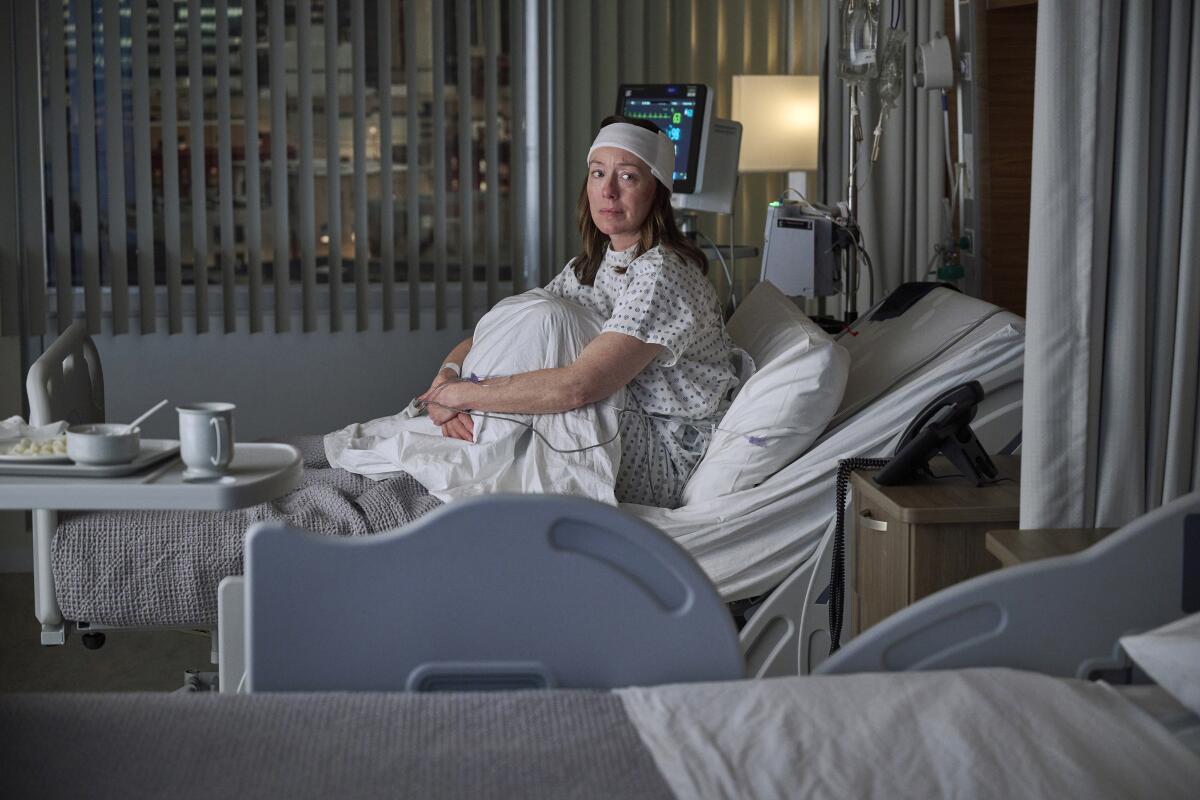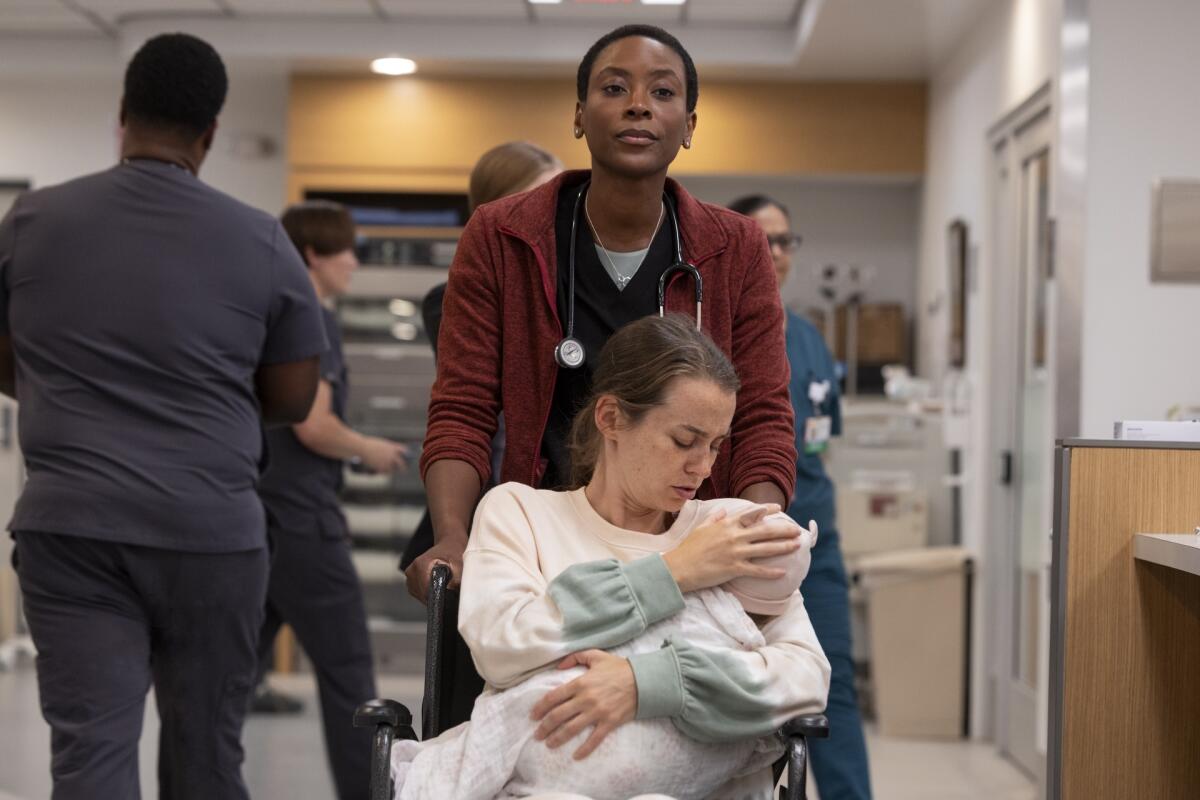‘The Pitt’ and ‘Doc’ review: Medical hyperrealism vs. melodrama

Judging by the content of television shows over the seven decades since the medium began, an alien race — you know they’re watching — would be justified in thinking the primary occupations of the human race to be solving crime and treating disease — which amount, substantially, to the same thing.
In life, no one wants to go to the hospital, yet people like to go there on television, I suppose in the same way that people like to watch shows about murder without being murdered. There is something crucial that happens in those places, which television grabs hold of and amplifies into high drama, both medical and existential. As the old “Ben Casey” titles used to go: “Man, woman, birth, death, infinity.” (Those were binary times.)
Two new series join the long parade of hospital shows this week. Fox’s “Doc,” which premiered Tuesday, stars Molly Parker as Dr. Amy Larsen, a Minneapolis internist who loses eight years of memory in a car crash but keeps on keeping on. “The Pitt,” now streaming on Max, is set in a Pittsburgh emergency room; that it involves “ER” vets John Wells (executive producer, director), R. Scott Gemmill (creator) and Noah Wyle (star) makes it impossible not to mention that show, so I have.
“Doc” is a soap opera with medical elements; “The Pitt” is a hyper-realistic medical drama with soap opera elements. Both offer a critique of bedside manner; patients that, seemingly fine, suddenly lose consciousness; red herrings, dead ends and wrong trees to bark up.

Molly Parker stars as a doctor dealing with memory loss in the Fox drama “Doc.”
(Christos Kalohoridis / Fox )
Adapted by Barbie Kligman from an Italian series, “Doc” begins in the aftermath of the crash; we get to see something going on inside an open skull, and then we meet Amy, whose misadventure has left her with no more than a bandage on her head, a possibly permanent case of partial retrograde amnesia and the cognitive dissonance that, as a virtual time traveler, assails her at every turn.
She will encounter the husband to whom she finds she’s no longer married, now running the hospital (Omar Metwally as Dr. Michael Hamda) where she worked, and her suddenly teenage daughter, Katie (Charlotte Fountain-Jardim); neither know quite what to make of her. And she’ll learn that her son is dead, a trauma that turned her cold and made her unpopular at work and with patients, though no less super powerful a diagnostician — which she remains. Confused? So is everyone.
Neither does she recall the secret affair she’d been carrying on with the hunky chief resident, Dr. Jake Heller (Jon-Michael Ecker), who isn’t about to remind her; or know why Dr. Sonya Maitra (Anya Banerjee), who has completely escaped her memory, doesn’t seem to like her at all; or why the nurses mock her behind her back; or that Dr. Richard Miller (Scott Wolf), now in her old post as chief of medicine, is worried about something she used to know and hopes she won’t remember. Offering support are best friend Dr. Gina Walker (Amirah Vann), the hospital psychiatrist, and young Dr. TJ Coleman (Patrick Walker), inspired by Amy to practice medicine.
In no time at all, Amy is wandering the halls, peeking in on patients, getting underfoot. Bumped down to a sort of a shadow doctor, trailing her colleagues like an intern — she has to retake her medical boards — she will nevertheless discover most of what needs to be discovered. But she stays humble about it. “Never saw you deferring to anyone before,” observes Dr. Miller. “Fresh start, new rules,” says Amy. “That sounds like the tag line for a really bad sitcom.”
It’s not a comedy, but in a way it is — second chances and all. And Parker, who shines a light all over the show, is particularly delightful and moving in her reborn persona. “Doc” can be a little corny, a little too obviously like television, when it comes to the cases, but is all in all quite entertaining.
There are more jokes in the 15-episode “The Pitt,” which plays out in real time across a single day’s shift. Wyle stars as Dr. Robinavitch, who goes by Dr. Robby. Alongside Tracey Ifeachor’s Dr. Collins, he runs things in the ER at the Pittsburgh Trauma Medical Center. Robby is loose (but focused) where Collins is tight (and focused — and also pregnant, but not telling anyone).

Tracy Ifeachor, top, co-stars as Dr. Collins in “The Pitt.”
(Warrick Page / Max )
Where “Doc” takes place on the quieter floors of a big city hospital, “The Pitt” — shot with peripatetic handheld cameras — is set in its noisiest part, the emergency room. There is no music, but machines beep constantly. There is much running and shouting. (One of the first sights we’re treated to is a naked man on the lam, crying: “No more needles.”) There are arguments as families are torn apart under pressure and violence against hospital staff and emergencies within emergencies. The waiting room, which we see briefly, is appropriately crammed with patients.
And the ER itself is crammed with doctors. There are a lot of characters to keep track of, not even counting the myriad patients and patients’ families, and it takes a while to sort them out.
Patrick Ball is the good-looking Dr. Langhorn, who has questions about dogs. Fiona Dourif plays Dr. McKay (what’s up with the ankle monitor, you will wonder), who can smell trouble. Dr. Mohan (Supriya Ganesh) spends more time talking with patients than your own doctor might so is called “Slo Mo.” Dr. King (Taylor Dearden), on rotation from the VA, is a cheerful, excitable sort who likes to high-five when something’s gone well. And charge nurse Dana (Katherine LaNasa) keeps everything running; she loves her job but would like a raise.
New to the room is a trio of student doctors — it’s a teaching hospital — on their first day: Javadi (Shabana Azeez) a prodigy at 20 but defensive about her age; competitive intern Dr. Santos (Isa Briones), who will need to learn there is no “I” in “team”; and gentle farm boy Whitaker (Gerran Howell). Santos calls him “Huckleberry.” (“It sounds like sarcasm,” he says. “You think?” she replies, sarcastically.) The question for them all is whether they can stand the pace, ride the roller coaster.
“This is the job that keeps on giving,” says Robby, “nightmares, ulcers, suicidal tendencies.” (The anniversary of the pandemic-era loss of a mentor haunts him through the day.)
Whether or not “The Pitt” reflects the life of an actual emergency room — do doctors chat about their lives while working over a patient or give them wheelchair rides? — it has a convincing energy. The actors have an easy way with the medical dialogue, the various needles and knives and tubes and paddles their characters need to use, the Purell they casually pump onto their hands on entering a room.
The doctors will take on cases of electrocution, drowning, overdose, trauma, scurvy, sickle cell anemia, a nail in the chest, a fastball in the eye, gallstones, third-degree burns, chlamydia, a faulty pacemaker, rats in the clothes of an unhoused man, and on and on, each with a story and a backstory.
The setting allows for a cross section of humanity, united in distress, and occasional passages of sociopolitical commentary. In its mix of cool authenticity and hot theatricality, of cases to solve and personal business to arrange, “The Pitt” reminded me of “Homicide: Life on the Street.” I never watched enough “ER” for it to remind me of “ER.”





